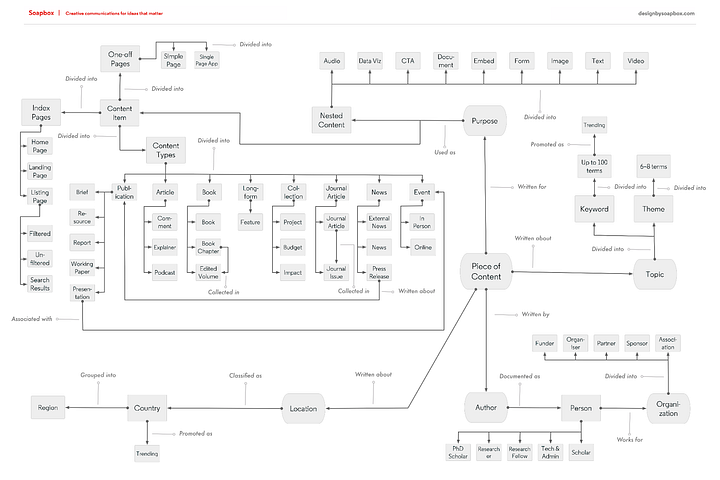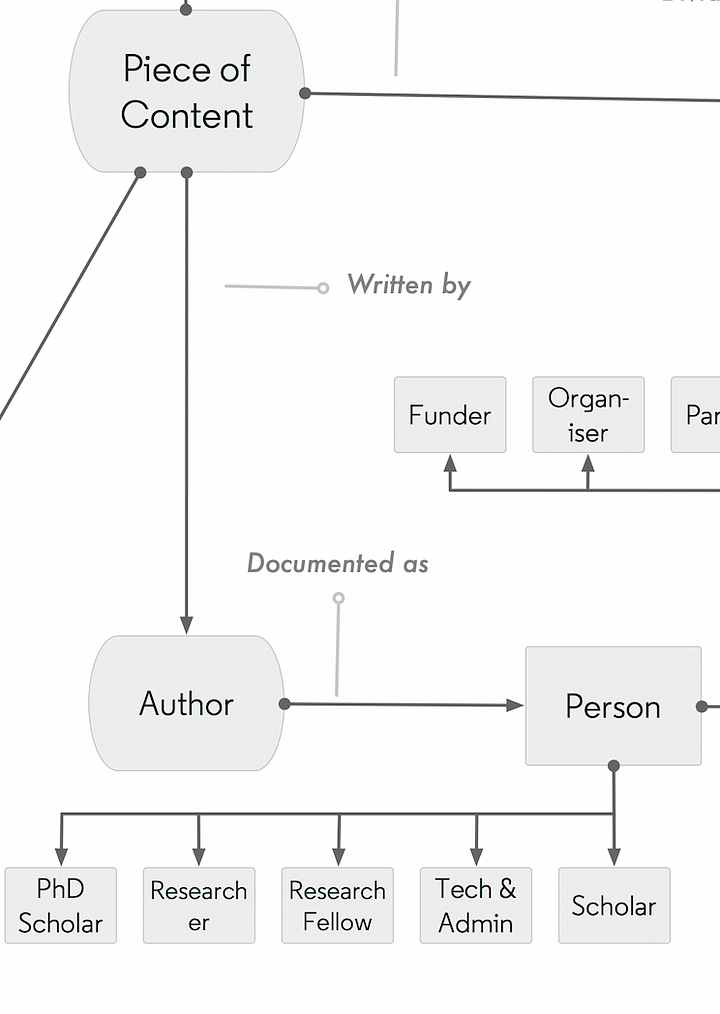At Soapbox, after the discovery phase of a website project– where we speak with product stakeholders and users, perform a content audit, and review website analytics — we begin the content strategy phase.
Content strategy builds on the older discipline of information architecture. At Soapbox, we produce three standard deliverables in this stage. Collectively, these form the foundation of your website. This foundation is often invisible as it takes into consideration how content is organized and structured both from a user-facing and internal perspective. These deliverables are:
- Domain model
- Content model
- Sitemap
We will discuss all these pieces of the Soapbox content strategy toolbox as part of this blog series but, for now, let’s focus on the first of these items– the domain model.

Why you need a domain model — and why you shouldn’t be afraid of it!
The domain model is a diagram that maps out the relationships between the kinds of content that your organization produces. A Soapbox content strategist will use your domain model to start laying down the foundation for your website. The domain model helps us understand:
- Ways that your content is currently structured and how it should be structured (aka, content types)
- The editorial functions that your content pieces play (is your piece of content a brief? A webinar? A profile of an expert?)
- People (authors) and organizations (partners) that produce and/or contribute to your content
- Topics (e.g., themes and keywords) and places (e.g., countries or locations) that your content is about
- Languages your content is written in
So, while this diagram can often look intimidating and you might just want to rush into wireframing in order to get started on your website’s new beautiful designs, this step is necessary and, honestly, not so scary. We’re simply mapping out all that we already know about your website — based on what you’re already doing on your website, and what you and your audiences need from your website (all of which we learned through the discovery phase). At the end of this exercise, you’ll know the content types, vocabularies and page types you’ll need to meet your needs and tell your organization’s story.
Want to go a step further? The domain model can also play a larger role within your wider communication strategy, if you let it. You can use it to uncover gaps within the content you’re currently producing, to cut out content pieces that no longer make sense for your users and organization, or to rebrand content pieces that no longer serve the same editorial purpose as they once did.
Want to create something incredible? Don’t skip the research
Like I mentioned before, the domain model allows you to put together everything that you already know about your content and how it should be structured within your website. This means that there is a lot of preparation before you can get started on the domain model.
At Soapbox, we do this work in the discovery phase. In this phase, we speak with different stakeholders and users, and we evaluate the current website (if there is one). Within our sector of expertise– think tanks and policy organizations– most of our clients work in the same domain of research, evidence, and taking action. But, of course, not all think tanks think the same way! The way that an organization approaches their domain is determined by many factors including their branding, internal focuses and strategy, audience(s), etc.
The research we do during this phase allows us to get to know our client, their mission, goals, audiences, and expertise. Without understanding our client’s unique approach to their domain of expertise and their users’ motivations, challenges, etc. the domain model would not be able to tell the client’s unique story or cater to user needs. Therefore, if you want to create something incredible — never skip the research.
Ready to start mapping?
Determine how your content will be organized
Starting your domain model might seem somewhat overwhelming at first. But, remember, this stage of the process is not yet a technical one. Before you start, it’s helpful to take stock of your content inventory. Suppose you’re an independent bookseller and you’re setting up your online store, you’d take a look at all the different facets or categorizations that help to identify the books you’re listing on your site. In this case, facets would be genre, author, language, etc. Once you’ve mapped out all the different facets, the next step is to map out their relationships.
In this example, we could make connections between authors and language or authors and genres. Mapping these facets out and the relationships between your different facets allows you not only to help users find books based on their preferred genre, author, or language, but it helps users discover books by drawing relationships between their preferred genre and an author they’ve yet to discover. By making this connection, you could now create a page specifically for science fiction books and feature the profiles of iconic or up-and-coming sci-fi writers for users to discover more of their work. In this example, science fiction is a classification of the “genre” facet. The classifications you identify will make up the vocabularies or taxonomies that will organize your content and serve readers with recommendations of other books within the same genre that they might also fall in love with.
Now back to our area of expertise — research and evidence-based content, we’ll start out with a block labelled “piece of content.” From there, you can begin adding relationships to the model by identifying facets that can be used to classify your piece of content. For example, you know that any piece of content on your website will be written by an “author.” So you draw an arrow coming out from “piece of content” and leading to “author” with the annotation “written by.”

Similarly, you can add “location” and “subject” as facets with the annotation “about a.” When written out this relationship looks like a “piece of content is about a location or/and subject.”
Let’s explore the relationships that stem from the location facet to understand how we can expand this model further. Based on the organization and audiences, this facet might be classified in different ways. It could be divided into countries, regions, cities, etc. Identifying these relationships will allow us to know that creating a vocabulary list of countries, for example, is an important facet to use in order to organize your content and make it easier for your users to search/find it. As a result, we will add a country vocabulary or taxonomy to your CMS that you can use to tag your content pieces in order to; for example, automate your content within listing/landing pages, add a country filter option to the sitewide search page, and populate related content alongside a content item.

Side note: At this stage you’re not adding terms to the different vocabulary lists you identify within the domain model. You’re solely identifying which vocabularies lists will be used to classify and organize your content.
Determine how your content will be structured
Another facet that you want to identify for your “piece of content” is the format it’s presented in. Here’s where you’ll identify which content types, types of pages, and types of nested content make sense based on user and stakeholder needs. The content types that a content item can be divided into will determine the structure of your content based on its purpose. For example, if a piece of content is an event, it will contain different fields and structural needs than a report or publication might.
As you identify these content types, you’ll also want to identify subtypes. Think of content types as templates made up of a set of attributes. If two pieces of content require the same attributes then they will use the same template, or content type. For example, a conference and a seminar are both events that contain the same attributes — users will need to know event logistics (time, date, location), a brief summary of the event itinerary, speakers/instructors, etc. However, these are two different types of events. Subtypes help you to further define your content to make its editorial purpose (or what my colleague Joe calls “rhetorical function”) known to your users.
In the domain model, you can also identify what pieces of nested content you’ll need to add within your content types that will help your piece of content come to life. By “nested content,” we’re referring to content items that exist within your content pieces like images, video, audio, documents, embeds, etc. These content items are not stand-alone content pieces; instead, they serve to support your content and add to your story. So, for example, a piece of nested content could be a data visualization within a report that you’ve published on your website. The data visualization does not make sense on its own as a piece of content because it lacks the context that is provided by the corresponding publication. However, it is incredibly valuable as a piece of nested content within your report that helps to support the claims you’re making.
And, finally, your piece of content can also be presented on a page. Within our sector, clients usually make the most use of one-off pages and index pages. One-off pages are just like what they sound; they don’t lead the user to other content. All information is housed and presented within that one page. Index pages can be further divided into your homepage, landing pages, and/or listing pages. These types of pages will all create different experiences for the user and allow you, as the website administrator, to create different levels of curation and automation for your content.
So, you mastered your domain model, now what?
After completing this exercise, treat yourself to a drink and some lunch — you’ve earned it. Then, we pull up our sleeves and get started on your site’s content models, which map out the attributes for each content type, component, and page on your website. These models will serve as the blueprints for your site’s information architecture that will be used by our designers and web developers to create beautiful functional designs for your website.